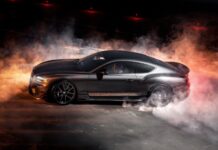The Zeekr 7X, a new electric SUV from Chinese brand Zeekr, aims squarely at established players like Tesla, Volkswagen, BMW, and Audi. While its design might not stand out dramatically—featuring familiar modern SUV cues—it boasts distinctive full-width front lighting and an interesting detail on the D-pillar. Notably, the raised “taxi light” bump above the windscreen houses the lidar and radar sensors, a trend seen increasingly in electric vehicles from brands like Volvo and Nio, indicating the growing importance of autonomous driving technology.
Zeekr is yet to officially launch in the UK, but information from other markets reveals a three-tiered lineup: Core, Long Range, and Privilege. The Core model boasts a 71kWh battery with an impressive 298-mile WLTP range, while the Long Range upgrades to a larger 94kWh battery (with nickel-manganese-cobalt chemistry) for a 382-mile range. The top-spec Privilege receives that same large battery but adds a second motor for a staggering 637bhp output and a range of 337 miles.
Charging speed is another highlight: the 7X’s 800V architecture allows it to charge at up to 360kW, enabling a 10-80% top-up in just 16 minutes. Additional features include a heat pump and vehicle-to-load (V2L) charging functionality, along with standard 22kW AC charging.
Stepping inside the cabin reveals clear Tesla influence—a large 16in central touchscreen dominates the dashboard, controlling everything from climate to entertainment, including an unusual steering wheel adjustment function. While the overall design leans towards conventional, high-end trim details add a touch of luxury. Despite some potentially questionable crystal accents, Zeekr clearly aims for perceived quality on par with established premium brands.
This flagship Privilege model is generously equipped. Heated and cooled eight-way electric front seats, a panoramic sunroof, two wireless phone charging pads, Matrix LED headlights, and advanced driver-assistance systems come standard. An optional package further elevates the experience with a 36in head-up display and a 21-speaker sound system.
The 7X offers ample space throughout. Rear seats are heated and electrically reclining, boasting individual climate control, while 90-degree opening doors enhance access for passengers, especially families with young children. A generous boot floor provides 539 liters of cargo capacity, comparable to rivals like the Skoda Enyaq.
During our test drive in the top-spec Privilege model (powered by dual motors and boasting 637bhp), it was evident that this is a car prioritizing comfort over outright driving thrills. While capable of achieving a respectable 0-62mph time of 3.8 seconds, it lacks the handling finesse expected from such performance figures. The long accelerator pedal travel further dampens the sense of immediate response even in Sport mode.
Regenerative braking offers multiple settings (including one-pedal operation) accessible through the touchscreen, though physical paddles on the steering wheel would be more intuitive. Despite this minor inconvenience, the system is well-tuned and seamlessly integrated.
Refinement and performance are undeniably strong points for the Zeekr 7X, posing a credible challenge to Tesla in terms of overall package. However, it lacks unique elements that differentiate it from competitors.
The real value proposition likely lies in the single-motor, rear-wheel-drive versions, which offer excellent range and performance at more accessible price points. These models appear to strike a better balance for everyday use compared to the power-laden Privilege model we sampled.
While comfortable thanks to standard adaptive air suspension that provides a pillowy ride even in Sport mode, the 7X leans towards a somewhat soft-edged character that may not appeal to drivers seeking sharper handling feedback. It’s adequate by class standards but less engaging than alternatives like the Tesla Model Y or Skoda Enyaq.























